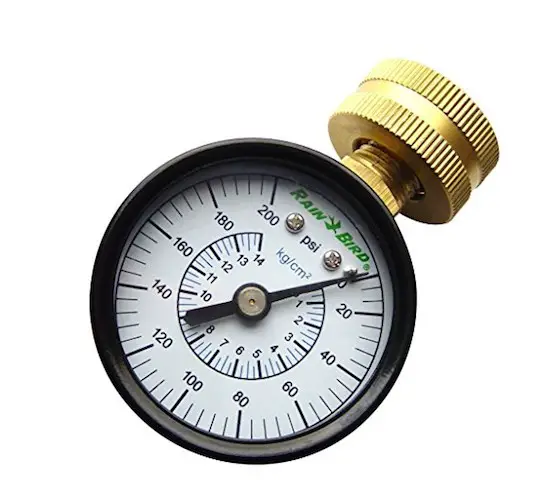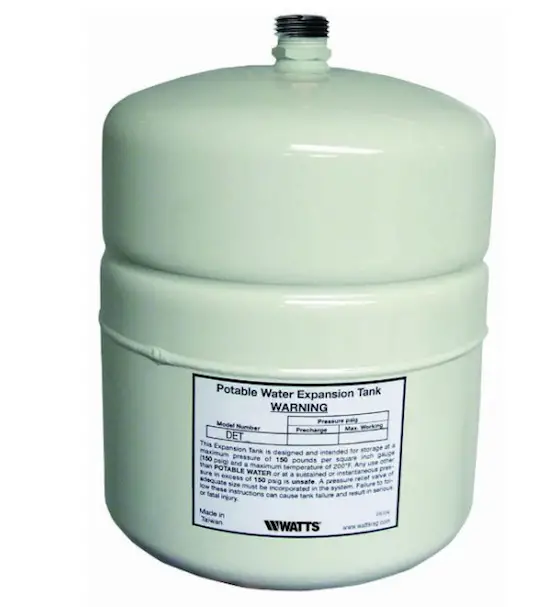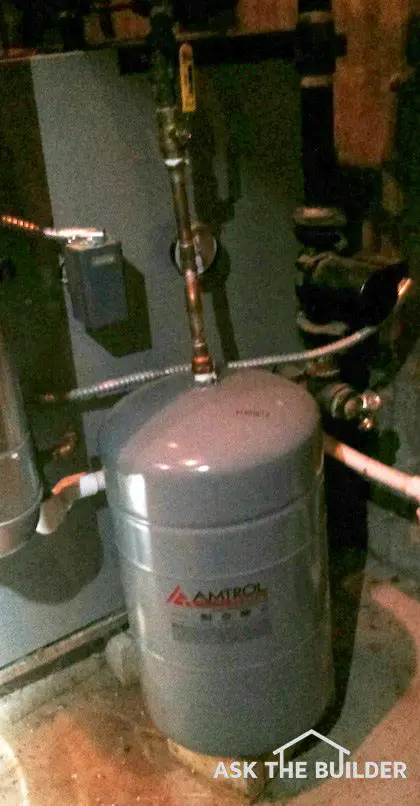Water Heaters – Expansion Tanks
Water Heater Expansion Tank TIPS:
- Must be sized to the heater
- Installing sideways is a leak potential
- Follow install instructions
- Use pipe thread compound, not teflon tape
- CLICK HERE to Get Tim's FREE & FUNNY Newsletter!
This column was so popular, Tim shared it with all of his Newsletter Readers in the November 1, 2015 Newsletter.
Virtually, every modern plumbing code requires the installation of an expansion tank on hot water heater installations. The reason is simple.
Water expands when heated. This extra volume of water needs to go somewhere.
Back Out To The Main
Before the widespread usage of back flow preventers, check valves and pressure reducing valves, this expanded water simply pushed the cold water back into the city water main.
If your house has one of the above mentioned devices, you could have problems. These devices prohibit the flow of water from your house back into the public water system.
Without an expansion tank, the expanding water can cause your hot water heater to possibly fail because of the increased pressure. This pressure can cause serious life threatening problems as well, if you heat your water with natural gas or propane.
The water heater tank can collapse around the internal flue and cause carbon monoxide to enter your home. It's serious business.
CLICK HERE to get FREE & FAST BIDS from local plumbers who can install an expansion tank.
Expansion Tanks
Expansion tanks are really simple devices. They contain compressed air and a special rubber bladder.
When your water heater turns on, the water within your piping system begins to expand. This expanding water enters the expansion tank. Eventually, hot water is drawn from the system thru a faucet and the expansion tank releases the extra water into the piping system.
Different Sizes
Expansion tanks come in various sizes. The size you need depends upon two very important variables:
- water heater capacity in gallons
- water pressure of your water supply system
The capacity of your hot water heater is stamped on a label or a plate on the side of your hot water heater.
Water pressures within municipal water systems vary widely. I used to live in Cincinnati, Ohio. There the water main pressures could vary from 50 pounds per square inch (PSI) to over 200 PSI within a distance of a mile!
This same thing may be true in your city.
Well Water Pressure
People with cisterns or wells control their own system pressure thru the use of electric pumps. I now live in a rural area with a water well.
My well pump delivers 50 PSI. You can purchase booster pump systems to get the pressure higher. I'd not recommend an internal water pressure in a residential home above 75 PSI.
DIY Pressure Testing
It is easy to determine your incoming water pressure. CLICK HERE to buy a little gauge that attaches to any faucet which has garden hose threads.

You can use this inexpensive pressure gauge at your own home. It attaches to any hose bib or a laundry sink faucet with hose threads. CLICK THE IMAGE NOW TO ORDER ONE.
Or if you like, you can call your local water department. They will possibly send a technician to your house. This person has very accurate gauges which will do the same thing.
Buying a Tank
CLICK HERE NOW to purchase with the proper sized expansion tank to suit your needs.

This is a good expansion tank. You can see how they connect at the top to the plumbing water pipe. CLICK THE IMAGE NOW TO ORDER ONE.
Be sure to follow the directions that are packaged with the expansion tank. It only takes a few moments to read them. This will insure that your tank will function properly.
If you install a pressure reducing valve to control water hammer, be sure to buy one with a bypass feature. Without this, your water heater will begin to malfunction. You will see water dribble out of the pressure/temperature safety valve without a doubt.
The reason lies in the fact that heated water expands. Without a pressure reducing valve, this expanded water can easily go right back outside to the water main. Low quality or malfunctioning pressure reducing valves block this backwards flow of expanding water.
An inexpensive expansion tank installed on the cold water side of your hot water heater will solve this problem. The tank absorbs the expanding water and then releases it once hot water is drawn from the hot water heater. They are simple yet effective devices.
CLICK HERE to get FREE & FAST BIDS from local plumbers who can install an expansion tank.
Installing an Expansion Tank
The first thing you need to do is to size the expansion tank according to the size of your hot water heater. The tank manufacturers make this easy. All you have to do is to determine the capacity of your hot water heater.
This is always stamped on the side label of the hot water heater. You may have a 50 gallon or 80 gallon or whatever size hot water heater. Take this information to your plumbing supply house to get the right sized expansion tank.
A Simple Tee Fitting
The expansion tank installation requires you to install a simple tee fitting in your cold water supply line. I like to install the tee, when possible, on a horizontal run of pipe, not a vertical piece.
Out of this tee fitting you should extend a piece of pipe towards the floor. Many plumbers will just try to hang the tank up in the air.
This causes all sorts of stress on the pipe and fittings. Imagine holding out your arm with a half-filled two-liter bottle of soda. Your arm gets fatigued and so will the pipe.
It's better, in my opinion, to install the tank on the ground with a ball valve shutoff valve about a foot above the tank. Place the tank on some wood blocks.

You can see the yellow handle of the shutoff valve above the tank. Note the wood blocks. - © 2017 Tim Carter
Doing it this way allows you to easily change out the tank without cutting off the water supply to the rest of the house. At some point, you'll have to install a new tank as they can get waterlogged.
Be sure to ALWAYS read the instructions provided by the manufacturer.
The tanks simply have a threaded connection. You will install the opposite type threaded adapter to your tee fitting. Apply Teflon tape or pipe dope to the male threads and screw the tank onto the fitting. To get a tight fit, you may have to use a pipe wrench or a leather belt around the tank. Most tanks come with a place to attach a tightening wrench. Follow the instructions and this can be done in 1/2 hour or less!
CLICK HERE to get FREE & FAST BIDS from local plumbers who can install an expansion tank.
Column B192
41 Responses to Water Heaters – Expansion Tanks